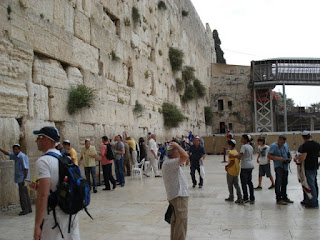Jerusalem, the capital of Israel, has about 800,000 people, 65% Jewish, 25% Arab, and 10% others. It is not a very clean city, especially in the Arab sections. It is very hilly.
The Hebrew University of Jerusalem has a beautiful campus on top of one of the famous hills, the Mount of Olives. The university seems to have a lot of money. Here's why. There is a lengthy list of donors who gave over a million dollars each, including such Canadians as various Bronfmans, Poslums, and Ormuts.
From the Mount of Olives you have a beautiful view of the Old Walled City of Jerusalem. If you look closely, you can see the city wall about 3/4 the way to the gold dome. The gold dome, in the Old City, is the roof of the Dome of the Rock, a Muslim Mosque, which is the third holiest site in Islam. The Garden of Gethsemane is in the foreground, outside the walls of the Old City.
Down at the Garden of Gethsemane you can look across a valley with an olive grove to the walls of the Old City of Jerusalem.
Our guide, Ron, is explaining some famous rock in the Garden of Gethsemane, but we can't remember what it is.
Olive trees live forever it seems. Here, in the Garden of Gethsemane, is one that is reputed to be 2,000 years old. If so, this tree was here when Jesus was. It must have some stories to tell.
Here, in its own church, we saw Mary's tomb, but did not get a good picture of it.
We entered the Old City through the Dung Gate, near the Wailing Wall in the Jewish Quarter. The Wailing Wall, also known as the Western Wall is a high stone wall on the western side of the enclosed area for the Dome of the Rock Mosque. It is the holiest site in the Jewish world as it is believed to be where the Holy Ark once stood. Pilgrims approach, touch the wall, and pray to God. In true Jewish tradition, the wall is divided into two sections, a large section on the left for the men, and a small section on the right for the women. Accordingly, the men have lots of room to do their wailing, while the women are jammed in at their little wall three or four deep. Peggy was unable to even touch the wall, while I had all kinds of room. So much for equality.
Here is a picture of the men's wall. See all the space.
Peggy is standing outside of the small wall that encloses the wailing area. See behind Peggy, all the space and spread out men on the left, and the limited space and jammed in women on the right.
Here is a better picture of the two sections of the wailing wall.
From there we cut through the Muslim Quarter, through the Bazaar on our way to the Christian Quarter. The bazaar is great, but no time for shopping as we made our way along the Via Dolorosa where Jesus is believed to have carried the cross to Calvary.
Some of the Stations of the Cross are well marked. Here are pictures of Stations V and VII.
At the end of the Way of the Cross, we arrived at the location where Jesus was crucified. It was at the top of a hill known as Golgatha. Now there is a church on this spot, the Church of the Holy Seplechre.
And here is the rock slab on which his body was laid.
This is a remnant of a stone pillar to which Jesus was chained and flogged.
It was amazing to see sites we have heard about for so many years. We left the Old City through the Jaffa Gate near the Armenian Quarter and headed back to Haifa and our home away from home.

















No comments:
Post a Comment